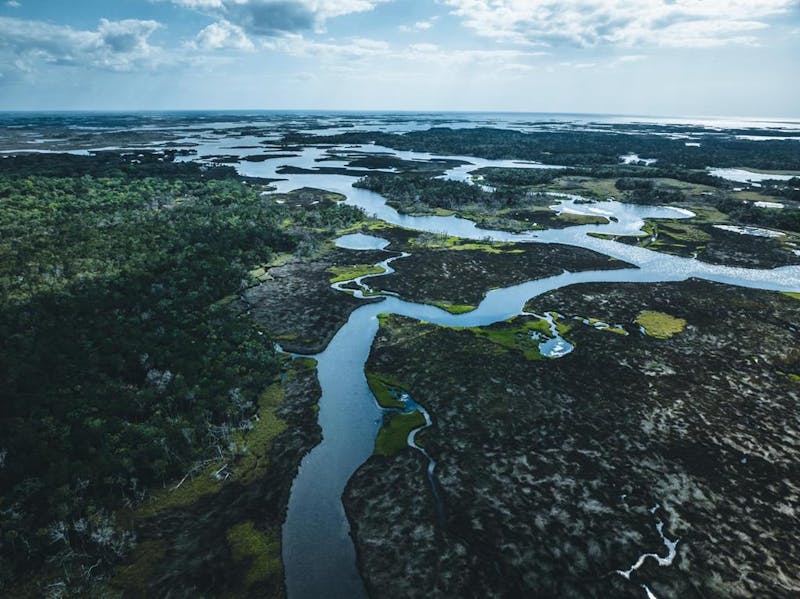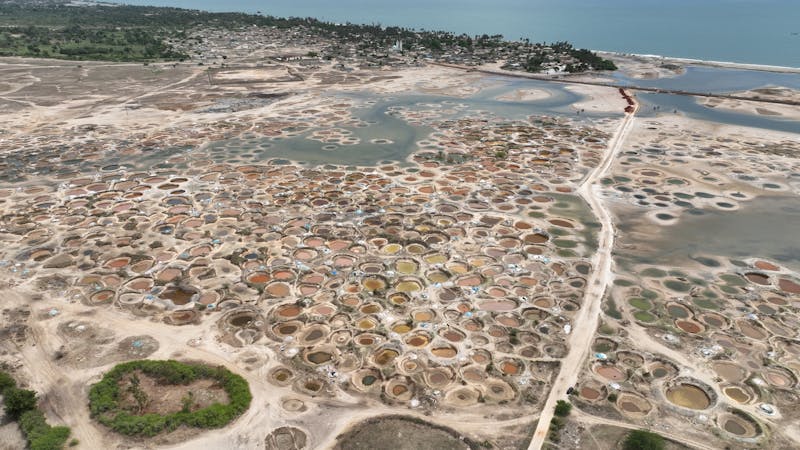To her fans, DJ and music producer Jayda Guy is the Grammy-nominated artist spinning propulsive dance beats at some of the world’s biggest festivals.
But in a new documentary, Guy returns to her “nerdy” roots as a marine scientist — bringing viewers on a journey to explore one of nature’s most potent climate allies: blue carbon.
That’s the planet-warming carbon trapped in the soil and silt of mangroves, salt marshes and seagrass meadows that fringe nearly every continent on Earth. These ecosystems cover just 2 percent of the ocean’s surface, yet they account for
half of all the carbon buried in it.
The film, “Blue Carbon: Nature’s Hidden Power,” executive-produced by Conservation International, explores the threats facing blue carbon ecosystems and the people working to protect them. Featuring a score from Wu-Tang Clan’s
RZA and Brazilian pop-samba star Seu Jorge, it marries music, nature and climate action.
“This is science you can dance to,” Guy says in the film.
 Guy holds a needle-nosed crocodile. Once critically endangered, they are now being released back into Colombia’s Cispata Bay. © Blue Carbon Film
Guy holds a needle-nosed crocodile. Once critically endangered, they are now being released back into Colombia’s Cispata Bay. © Blue Carbon Film
Guy, a self-described nerd who studied marine toxicology before becoming a DJ, travels from the seagrass meadows of Florida to the mangroves of Colombia, Senegal and Vietnam to the salt marshes of France. In every ecosystem, a new story unfolds. She meets
climate refugees and ranchers, scientists, artists and activists whose communities are deeply connected to nature — and who are facing the consequences of its destruction from extreme storms, sea-level rise, coastal development and war.
For director Nicolas Brown, the film offered an opportunity to explore climate solutions in the “unloved parts of nature.”
“These liminal zones between the ocean and the land have previously been thought of as no-man’s land — they’ve been bulldozed, drained or paved over,” Brown said. “Then you suddenly realize that these could be some of the
most valuable ecosystems on Earth. That, for me, was one of the [film’s] big attractions: to find hope in an unlikely place.”
 In Florida, the Homosassa River
In Florida, the Homosassa River
and its tributaries are a major carbon sink. © Freddie Claire
Investing in blue carbon
That optimism is most palpable in Colombia, where Guy delves into Conservation International’s pioneering blue carbon project — the first to fully measure and monetize the carbon sequestered in the soil of an 7,600-hectare (19,000-acre) mangrove forest along the country’s Caribbean coast.
For decades, Cispatá Bay’s mangroves were cleared for cattle and agriculture. Though the area was protected on paper, there were few resources or incentives to restore it. Working with local partners — including Colombia’s Marine and Coastal Research Institute (INVEMAR), the country’s environmental authority of the Sinú River, the nonprofit Omacha Foundation and 14 community-based associations of mangrove workers — Conservation International saw an opportunity to change that.
Scientists found a way to measure and value the climate benefits of the blue carbon locked away in the mangroves’ tropical sediment. The resulting credits — that is, verifiable emissions reductions tied to that carbon — were sold to investors, with 92 percent of the proceeds plowed back into Cispatá’s conservation.
Essentially, the mangroves are now helping to pay for their own protection.
 Vida Manglar’s long-term success relies on support from local communities, which are part of the project’s governance. © Blue Carbon Film
Vida Manglar’s long-term success relies on support from local communities, which are part of the project’s governance. © Blue Carbon Film
Funds from the blue carbon credits support jobs for local people, who clean the bay’s waterways, monitor species and help gather soil samples for carbon assessments. Families who have lived in the bay for generations are part of the project’s
governance structure and actively participate in its protection.
“It’s a different type of system that puts people first,” Guy says in the film. “But specifically, the people who have been marginalized by climate change.”
Critically, the project, known as “Vida Manglar” (Spanish for “mangrove life”), provided proof of concept to bring blue carbon credits to a broader market. Since the project’s launch, Conservation International has helped develop a set of principles to guide blue carbon projects — drawing from lessons learned in Cispatá Bay.
“Blue carbon ecosystems are finally being recognized for the climate heroes they are, and we’re doing everything we can to seize on this momentum,” said Conservation International marine scientist Emily Pidgeon, who has been studying blue carbon ecosystems for 15 years and served as an adviser for the film. “That includes drafting guidance for blue carbon investors, leading research and promoting policies to protect them.”
To avoid a climate crisis, the world must quickly cut fossil fuel emissions while also removing excess carbon from the atmosphere — “and these ecosystems are some of the most efficient on Earth at doing that,” Pidgeon added.
Plant and protect
Despite their value, blue carbon ecosystems are quickly disappearing. Globally, half of salt marshes and two-thirds of mangroves have been degraded or destroyed. And the cost to communities is high.
 Senegal’s Sine Saloum Delta includes salt flats, mangrove forests and open estuaries. © Nicolas Brown
Senegal’s Sine Saloum Delta includes salt flats, mangrove forests and open estuaries. © Nicolas Brown
Not only do these coastal areas store carbon — often for hundreds or even thousands of years — they also act as natural buffers, helping millions of people become more resilient to sea-level rise by blunting storm surges and floods. Their dense root systems help stabilize shorelines and reduce erosion.
They also serve as nurseries for countless fish species and are at the heart of countless communities’ lievlihoods. And coastal ecosystems can offer sources of tourism revenue in places that are adapting to climate change. Cispatá Bay, for example, is home to one of the most accessible nesting colonies of the elusive agami heron — a coveted sighting for birders. Avid birdwatchers, who travel long distances for a glimpse of this rare species, are suporting community-driven ecotourism, including lodges and local guides.
“It’s been a revelation to me that blue carbon ecosystems can help us tackle so many of the impacts of climate change,” Guy says near the end of the film. “There is no technology we humans can invent which is as powerful or as versatile.”
“We just need to plant and we need to protect,” she adds. “Nature will do the rest.”
“Blue Carbon: Nature’s Hidden Power” will stream live for pay TV subscribers via CNN.com, CNN OTT and mobile apps on Sunday, April 21. The film will be available on demand beginning Monday, April 22 to pay TV subscribers via CNN.com, CNN apps, and cable platforms.
Make Waves and HHMI Tangled Bank Studios produced the film. In addition to Conservation International support, it received funding from Fondation Erol and Ocean Born Foundation, alongside European broadcasters, NDR (Germany) and Canal+ (France).
Further reading:
Vanessa Bauza is the senior communications director at Conservation International. Want to read more stories like this? Sign up for email updates here. Donate to Conservation International here.

